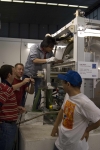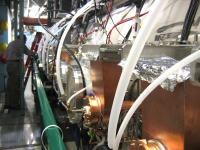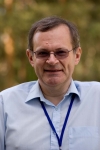ECFA meets at DESY

ECFA hopes that initiatives like EUDET will continue the detector development effort in Europe.
Photo: DESY |
In their meeting a couple of days ago at DESY, ECFA, the European Committee for Future Accelerators, got a complete update on all present and future particle physics activities in Europe. They also discussed the ILC and its potential: “We think it is important to remember that particle physics in Europe is more than the LHC,” says the current ECFA chair Karlheinz Meier from Heidelberg university in Germany. “The community has to plan now, gather facts and lay foundations for future projects, and the ILC is a very good example for this.”
Read more...
-- Barbara Warmbein |
|
 |
Time to recover
Cornell University is testing a prototype injector for an Energy Recovery
Linac

Finishing touches to the ERL prototype injector at Cornell. |
In a linear accelerator, energy conservation is not really on the achievement list. To get up to the required luminosity, accelerator experts have one chance to push the particle beams to their limits, putting much energy into the bunches, correcting, scraping and tweaking them along the way only to smash them into each other and direct the straggly remains into a dump. Not so an Energy Recovery Linac, currently at the design and first prototype stage at Cornell University. The electron beams also get dumped after one run, but before that happens, they are tricked into handing over their energy back to the superconducting machine that accelerated them.
Read more...
-- Barbara Warmbein |
 |
|
|
 |
From symmetry breaking
29 July 2008
Rapping the LHC
...The rap is the brainchild of Kate McAlpine, a.k.a. alpinekat, a freelance science writer and one of the editors of the ATLAS e-News.
Read more... |
|
From Innovation le Journal
29 July 2008
LHC : Confirmer la présence d'autres dimensions
L’observation de la vie de ces particules pourrait mener à la découverte de particules super symétriques, des répétitions de particules connues à des masses plus grandes.
Read more... |
|
From Discover Magazine
24 July 2008
The Extremely Long Odds Against the Destruction of Earth
Don't be too concerned that the world’s largest particle accelerator is about to go online.
Read more... |
|
From interactions
24 July 2008
First e+e- Collison at BEPCII/BESIII
On late Saturday afternoon July 19, researchers at the Chinese Academy of Science’s Institute of High Energy Physics in Beijing produced for the first time collisions in the upgraded BEPC-II electron positron collider that were observed in its brand new associated detector called BES-III.
Read more... |
|
|
 |
New hope for Europe

Brian Foster |
My last Director's Corner in January summarised the situation in Europe as far as it could be discerned through the still-settling dust after "Black December". Six months later, it is appropriate and useful to revisit the new landscape in Europe. The good news is that very little has changed outside the UK. The strong involvement in many of the other European states has not been affected by "Black December"; fortunately, it has been recognised for what it was, a one-off, knee-jerk reaction to a funding shortfall, rather than any sort of considered judgement as to the merit of the ILC project or the ongoing R&D programme.
Read more...
-- Brian Foster
Director's Corner Archive |
 |
|
|
 |
SLAC celebrates Jonathan Dorfan

The word most used on the SLAC campus on 24 July was without a doubt 'Jonathan'. With nearly 300 internationals guests and speeches and celebrations moving from the Panofsky Auditorium to the SLAC Green to the Stanford Faculty Club, the symposium honouring form SLAC-Director Jonathan Dorfan's career and leadership of the lab was a huge success.
Photo: Seth Restaino, SLAC
|
|
arXiv preprints
0807.3847
SO(3) Gauge Symmetry and Nearly Tri-bimaximal Neutrino Mixing
0807.3775
Looking up at seesaw and GUT scales from TeV
|
|

